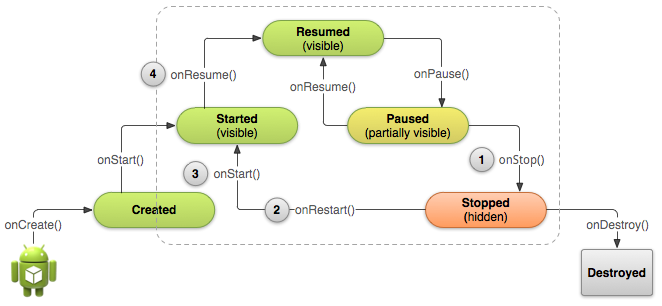- Android 培训
- 序言
- 1. Android入门基础:从这里开始
- 2. Android分享操作
- 3. Android多媒体
- 4. Android图像与动画
- 5. Android网络连接与云服务
- 6. Android联系人与位置信息
- 7. Android可穿戴应用
- 8. Android TV应用
- 9. Android企业级应用
- 10. Android交互设计
- 11. Android界面设计
- 12. Android用户输入
- 13. Android后台任务
- 14. Android性能优化
- 15. Android安全与隐私
- 16. Android测试程序
停止与重启Activity
编写:kesenhoo - 原文: http://developer.android.com/training/basics/activity-lifecycle/stopping.html
- 恰当的停止与重启你的activity是很重要的,在activity生命周期中,他们能确保用户感知到程序的存在并不会丢失他们的进度。在下面一些关键的场景中会涉及到停止与重启:
- Activity类提供了onStop()与onRestart()方法来允许在activity停止与重启时进行调用。不像暂停状态是部分阻塞UI,停止状态是UI不再可见并且用户的焦点转移到另一个activity中.
Note:因为系统在activity停止时会在内存中保存Activity的实例。有些时候你不需要实现onStop(),onRestart()甚至是onStart()方法. 因为大多数的activity相对比较简单,activity会自己停止与重启,你只需要使用onPause()来停止正在运行的动作并断开系统资源链接。

Figure 1.上图显示:当用户离开你的activity,系统会调用onStop()来停止activity (1). 这个时候如果用户返回,系统会调用onRestart()(2), 之后会迅速调用onStart()(3)与onResume()(4). 请注意:无论什么原因导致activity停止,系统总是会在onStop()之前调用onPause()方法。
停止activity
- 当activity调用onStop()方法, activity不再可见,并且应该释放那些不再需要的所有资源。一旦你的activity停止了,系统会在不再需要这个activity时摧毁它的实例(和栈结构有关,通常back操作会导致前一个activity被销毁)。在极端情况下,系统会直接杀死你的app进程,并且不执行activity的onDestroy()回调方法, 因此你需要使用onStop()来释放资源,从而避免内存泄漏。(这点需要注意)
- 尽管onPause()方法是在onStop()之前调用,你应该使用onStop()来执行那些CPU intensive的shut-down操作,例如writing information to a database.
- 例如,下面是一个在onStop()的方法里面保存笔记草稿到persistent storage的示例:
@Override
protected void onStop() {
super.onStop(); // Always call the superclass method first
// Save the note's current draft, because the activity is stopping
// and we want to be sure the current note progress isn't lost.
ContentValues values = new ContentValues();
values.put(NotePad.Notes.COLUMN_NAME_NOTE, getCurrentNoteText());
values.put(NotePad.Notes.COLUMN_NAME_TITLE, getCurrentNoteTitle());
getContentResolver().update(
mUri, // The URI for the note to update.
values, // The map of column names and new values to apply to them.
null, // No SELECT criteria are used.
null // No WHERE columns are used.
);
}
- 当activity已经停止,Activity对象会保存在内存中,并且在activity resume的时候重新被调用到。你不需要在恢复到Resumed state状态前重新初始化那些被保存在内存中的组件。系统同样保存了每一个在布局中的视图的当前状态,如果用户在EditText组件中输入了text,它会被保存,因此不需要保存与恢复它。
Note:即使系统会在activity stop的时候停止这个activity,它仍然会保存View对象的状态(比如EditText中的文字) 到一个Bundle中,并且在用户返回这个activity时恢复他们(下一个会介绍在activity销毁与重新建立时如何使用Bundle来保存其他数据的状态).
启动与重启activity
- 当你的activity从Stopped状态回到前台时,它会调用onRestart().系统再调用onStart()方法,onStart()方法会在每次你的activity可见时都会被调用。onRestart()方法则是只在activity从stopped状态恢复时才会被调用,因此你可以使用它来执行一些特殊的恢复(restoration)工作,请注意之前是被stopped而不是destrory。
- 使用onRestart()来恢复activity状态是不太常见的,因此对于这个方法如何使用没有任何的guidelines。然而,因为你的onStop()方法应该做清除所有activity资源的操作,你需要在重新启动activtiy时重新实例化那些被清除的资源,同样, 你也需要在activity第一次创建时实例化那些资源。介于上面的原因,你应该使用onStart()作为onStop()所对应方法。因为系统会在创建activity与从停止状态重启activity时都会调用onStart().(这个地方的意思应该是说你在onStop里面做了哪些清除的操作就应该在onStart里面重新把那些清除掉的资源重新创建出来)
- 例如:因为用户很可能在回到这个activity之前需要过一段时间,所以onStart()方法是一个比较好的地方来验证某些必须的系统特性是否可用。
@Override
protected void onStart() {
super.onStart(); // Always call the superclass method first
// The activity is either being restarted or started for the first time
// so this is where we should make sure that GPS is enabled
LocationManager locationManager =
(LocationManager) getSystemService(Context.LOCATION_SERVICE);
boolean gpsEnabled = locationManager.isProviderEnabled(LocationManager.GPS_PROVIDER);
if (!gpsEnabled) {
// Create a dialog here that requests the user to enable GPS, and use an intent
// with the android.provider.Settings.ACTION_LOCATION_SOURCE_SETTINGS action
// to take the user to the Settings screen to enable GPS when they click "OK"
}
}
@Override
protected void onRestart() {
super.onRestart(); // Always call the superclass method first
// Activity being restarted from stopped state
}